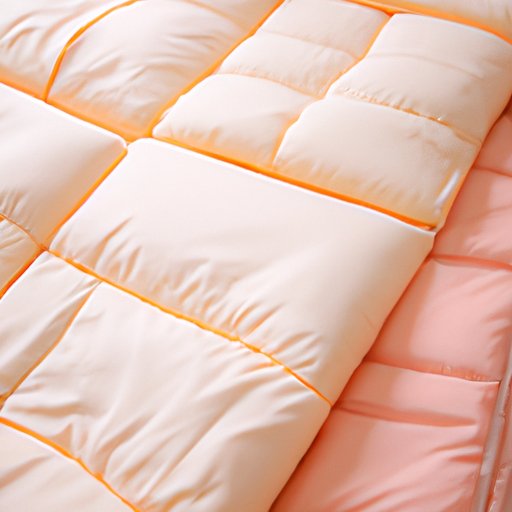I. Introduction
Washing a comforter may seem like a daunting task, but it’s an essential step in maintaining a clean and hygienic sleeping environment. A comforter acts as a sponge, absorbing sweat, oils, and dead skin cells, and can accumulate dust mites and other allergens. In this article, we will provide you with a step-by-step guide on how to wash your comforter, along with some top tips and tricks, common mistakes to avoid, and expert advice.
II. Step-by-Step Guide
A. Choosing the right detergent: The first step in washing your comforter is to choose the right detergent. It’s essential to select a detergent that is specifically designed for washing bedding and one that is suitable for your comforter material.
B. Preparing the washing machine: Before loading your comforter into the washing machine, make sure to clean the machine first. Remove any debris or lint, and run a cycle with hot water and a cup of vinegar to sanitize and deodorize the machine.
C. Properly loading the comforter: Place the comforter in the washing machine and make sure it is evenly distributed. Adding a few towels or sheets can prevent the comforter from bunching up and ensure that it gets cleaned thoroughly.
D. Choosing the right settings for washing: Select the delicate or gentle cycle on the machine to prevent any damage to the comforter. Use a cold water temperature setting and run the cycle through twice to ensure that the detergent is rinsed completely.
E. Drying tips and tricks: Once the washing cycle is complete, remove the comforter from the machine and place it in the dryer. Use a low heat setting and some dryer balls to help fluff the comforter and prevent clumping. It’s vital to make sure the comforter is completely dry to prevent mildew growth.
III. Top Tips and Tricks
A. Using vinegar to remove odors: Adding a cup of vinegar to the wash cycle can help to remove any tough smells or odors from the comforter.
B. Using dryer balls instead of dryer sheets: Dryer balls can help to separate and fluff the comforter fibers, making them re-fluff after washing.
C. Adding in extra rinse cycles: Adding in extra rinse cycles can ensure that all detergent is rinsed out of the comforter, helping to prevent any skin irritations or allergies.
D. Utilizing the delicate setting on the washing machine: It’s essential to avoid using a regular cycle as this could damage the comforter, instead opt for the delicate or gentle cycle for the best results.
IV. Product Reviews
A. Reviews of specific washing machines: Different machines come with varying features that may offer better results. Read up on product reviews and ask for recommendations from friends or family.
B. Detergent recommendations: Find a detergent that is suitable for your comforter material and has reviews that satisfy you.
C. Tools to make the process easier: Using tools such as a garment bag or a lint roller can help to make washing a comforter less cumbersome.
V. Common Mistakes to Avoid
A. Using too much detergent: Using too much detergent may result in a buildup on the comforter, making it more challenging to rinse the detergent away and resulting in stiff and scratchy material.
B. Using the wrong settings on the washing machine: Using the wrong settings on the washing machine can cause irreversible damage to the comforter material or negate its cleaning effect entirely.
C. Not properly drying the comforter afterwards: It’s vital to ensure that the comforter, even when seemingly dry to the touch, is fully dried before use to prevent mildew growth.
VI. Expert Advice
A. Interview with an expert on bedding or laundry care: Interviews with experts on bedding can offer vital insights into the care of comforters.
B. Top tips and insights for washing a comforter: Experts can provide expert advice on specific comforter materials and proffer tips on how to wash them effectively.
VII. DIY Options
A. Soaking the comforter in a bathtub: If you don’t have a washing machine large enough for your comforter, soaking in a bathtub with cold water and mild detergent can be an effective option.
B. Hand-washing the comforter: Hand washing is another option if you have a delicate comforter material.
C. Homemade detergent options: You can go natural and make your detergent using mild recipes that are gentle on comforter materials.
VIII. Choosing the Right Comforter
A. Best materials for easy cleaning: Consider using comforters made from cotton, synthetic materials, or blends of natural and synthetic.
B. Tips for selecting a comforter that can be washed in a standard washing machine: Check the care label on the comforter to see the recommended care instructions and ensure it can be washed in a standard washing machine.
IX. Conclusion
Washing a comforter, when done right, can increase its durability and overall hygiene, and now that you have read our step-by-step guide, you can go ahead and give it a try. We hope our article provided you with worthwhile insights and helped simplify the process for you!
Remember to avoid the common mistakes when washing your comforter, use the right detergent and settings, choose the right comforter material, and utilize the top tips and tricks mentioned in this article to help achieve an indoor environment that is thoroughly clean and hygienic.
